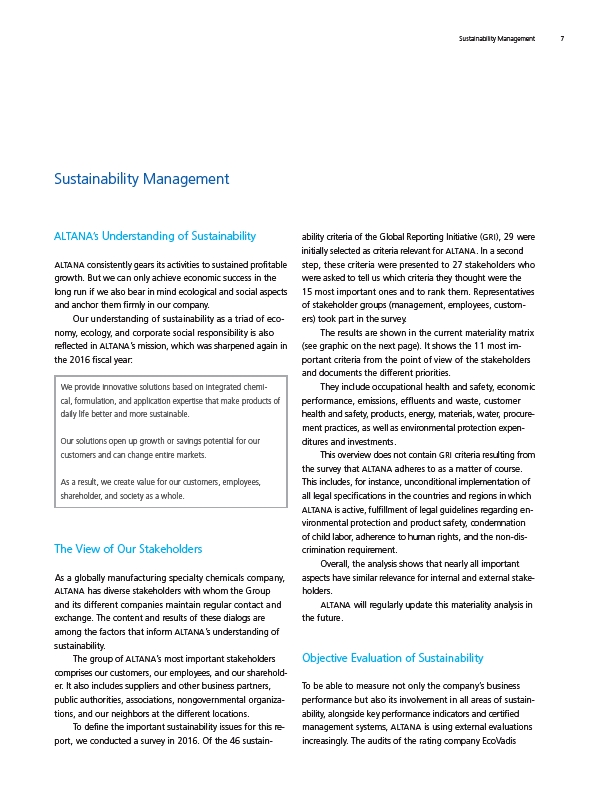
Sustainability Management
ALTANA’s Understanding of Sustainability
ALTANA consistently gears its activities to sustained profitable
growth. But we can only achieve economic success in the
long run if we also bear in mind ecological and social aspects
and anchor them firmly in our company.
Our understanding of sustainability as a triad of economy,
ecology, and corporate social responsibility is also
reflected in ALTANA’s mission, which was sharpened again in
the 2016 fiscal year:
We provide innovative solutions based on integrated chemical,
formulation, and application expertise that make products of
daily life better and more sustainable.
Our solutions open up growth or savings potential for our
customers and can change entire markets.
As a result, we create value for our customers, employees,
shareholder, and society as a whole.
The View of Our Stakeholders
As a globally manufacturing specialty chemicals company,
ALTANA has diverse stakeholders with whom the Group
and its different companies maintain regular contact and
exchange. The content and results of these dialogs are
among the factors that inform ALTANA’s understanding of
sustainability.
The group of ALTANA’s most important stakeholders
comprises our customers, our employees, and our shareholder.
It also includes suppliers and other business partners,
public authorities, associations, nongovernmental organizations,
and our neighbors at the different locations.
To define the important sustainability issues for this report,
we conducted a survey in 2016. Of the 46 sustainability
Sustainability Management 7
criteria of the Global Reporting Initiative (GRI), 29 were
initially selected as criteria relevant for ALTANA. In a second
step, these criteria were presented to 27 stakeholders who
were asked to tell us which criteria they thought were the
15 most important ones and to rank them. Representatives
of stakeholder groups (management, employees, customers)
took part in the survey.
The results are shown in the current materiality matrix
(see graphic on the next page). It shows the 11 most important
criteria from the point of view of the stakeholders
and documents the different priorities.
They include occupational health and safety, economic
performance, emissions, effluents and waste, customer
health and safety, products, energy, materials, water, procure-
ment practices, as well as environmental protection expen-
ditures and investments.
This overview does not contain GRI criteria resulting from
the survey that ALTANA
adheres to as a matter of course.
This includes, for instance, unconditional implementation of
all legal specifications in the countries and regions in which
ALTANA is active, fulfillment of legal guidelines regarding environmental
protection and product safety, condemnation
of child labor, adherence to human rights, and the non-discrimination
requirement.
Overall, the analysis shows that nearly all important
aspects
have similar relevance for internal and external stakeholders.
ALTANA will regularly update this materiality analysis in
the future.
Objective Evaluation of Sustainability
To be able to measure not only the company’s business
performance but also its involvement in all areas of sustainability,
alongside key performance indicators and certified
management systems, ALTANA is using external evaluations
increasingly. The audits of the rating company EcoVadis